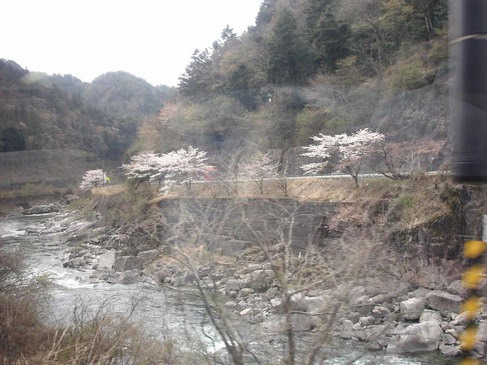It wasn’t as if there was a general lack of English-language guides in Takayama. When we’d arrived I’d been surprised to discover that the tourist information was available, not just in Japanese and English, but also in French and Italian.
 At least it gave me something to think about as we headed back to the hotel, reclaimed the suitcase and set off for the station and the 11:35 train to Nagoya, where we found, being seated further back than the day before we didn’t have quite the same view to the front.
At least it gave me something to think about as we headed back to the hotel, reclaimed the suitcase and set off for the station and the 11:35 train to Nagoya, where we found, being seated further back than the day before we didn’t have quite the same view to the front.
That’s not to say that the views to the side as we passed through forests and paddy fields, climbing back into the mountains and crossing the divide between the westward-flowing Miya River and the eastern-bound Hida, which we linked up with at Kugano, surrounded by forested slopes before moving downstream through fringing forest, past hydro schemes and mountain villages with the highway on our right-hand side.
As we headed towards the lower reaches, we also passed large sections of bare-branched forest amid swathes of green foliage. At first glance it seemed like these were belts of dead vegetation, but glimpses of some of the closer specimens suggested that these were deciduous trees amidst hardier evergreens which hadn’t quite redeveloped their foliage so early in the spring.
We stopped at Nagisa to let a train travelling in the opposite direction past, and while we were there lunch arrived in the form of an eki-bento (or station box) of Hida Gyumeshi (beef, rice and vegetables) which the handy pamphlet on the train informed us had been loaded on board at the Nagoya Station so I assumed the pause to let the other train, which had come from Nagoya, past might have something to do with loading lunch as well. In any case I enjoyed the box of lunch and the Kirin Lager I used to wash it down.
Eating kept us occupied as far as Gero, one of Japan’s top three hot spring resorts, where boarding passengers filled most of the vacant seats in the train. It’s obviously a popular destination with a history stretching back, according to the pamphlet, a thousand years. By this time we were also back among the cherry-blossom, which had been conspicuously absent higher up in the mountains.
Passing through forested hills Neil Young’s nine-minute Be The Rain, about fighting to defend the wilderness in Alaska, turned up on the iPod playlist; a pleasant piece of serendipity. By the time it had ended we were down on the river flats, travelling round sweeping curves beside what looked like a broad stream but was, in fact a dam with the train on one side and the highway on the other.
As we came out of the mountains and onto the river flats we started to pass low green mounded rows of a crop which I guessed was tea as the track moved away from the stream.
By the time we were twenty minutes out of Nagoya, we were up above ground level as we headed into Gifu station, heading back out of the station in reverse as we headed back to ground level with our backs to the driver, who I guessed had either swapped ends on the rail motor or been replaced. With only a bit over a quarter of an hour till we reached our destination I thought that was unlikely.
Following the usual routine, once we’d alighted in Nagoya it was a case of straight to the hotel though this time we were late enough to check in before heading back to the station to meet up with the first of our two appointments for the day.